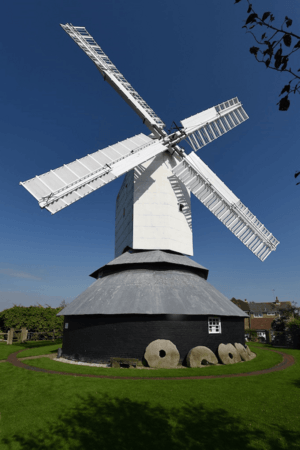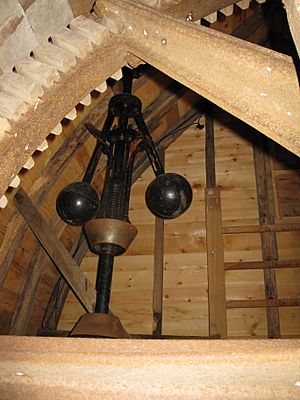Windmill Hill Mill, Herstmonceux facts for kids
Quick facts for kids Windmill Hill Mill, Herstmonceux |
|
|---|---|

The windmill at Windmill Hill, 2018
|
|
| Origin | |
| Grid reference | TQ 648 122 |
| Coordinates | 50°53′10″N 0°20′31″E / 50.886°N 0.342°E |
| Year built | ca. 1814 |
| Information | |
| Purpose | Corn mill |
| Type | Post mill |
| Roundhouse storeys | Two storey roundhouse |
| No. of sails | Four |
| Type of sails | Patent sails |
| Windshaft | Cast iron |
| Winding | Originally Tailpole, now by computer controlled battery powered electric motor |
| No. of pairs of millstones | Two pairs, arranged Head and Tail |
| Other information | Largest post mill in Sussex. Only surviving example of Hammond's Patent Sweep Governor is fitted to this mill. |
Windmill Hill Mill is a special type of windmill called a post mill located in Herstmonceux, Sussex, England. It is a protected historic building, listed as grade II*. After being carefully restored, it now works again, grinding corn just like it did long ago.
The mill is open for visitors on most Sundays from Easter until October, so people can see how it works up close.
Contents
The Mill's Story
Windmill Hill Mill was built around 1814 by a famous mill builder named William Medhurst. For almost 80 years, it used the power of the wind to grind grain. However, in 1893, a main wooden beam became weak, and the sails had to be stopped.
Even though the sails stopped turning, the millers kept working. They set up a steam engine inside the mill's circular base, called the roundhouse, to power the grinding stones. For many years after that, the mill was left abandoned and began to fall apart. Some of its main support beams were broken.
This windmill is the largest post mill in the county of Sussex. It's also the only one in the world with a special device called Hammond's Patent Sweep Governor. This clever invention helped control the speed of the sails automatically.
Bringing the Mill Back to Life
By 1994, the old mill was in very bad shape. To stop it from collapsing, a steel frame was built around it. A group called the Windmill Hill Mill Trust was formed in 1995 to save the building.
The project got a huge boost from the Heritage Lottery Fund, which provides money to save important historic sites. They gave a grant of £570,000 to help with the restoration. In 2003, the entire mill was carefully taken apart. The pieces were moved to a workshop where experts could repair them. They even used modern tools like computer-aided design (CAD) to plan the repairs.
During the restoration, they discovered that a type of insect called the Death Watch Beetle had damaged one of the main support beams, which had to be replaced.
On September 7, 2004, the rebuilt wooden body of the mill was lifted back onto its central post. A year later, in late 2005, the four huge sails were attached. Finally, on November 5, 2015, the sails turned in the wind for the first time in 120 years.
How the Mill Works
Windmill Hill Mill is a post mill, which means its whole body can be turned to face the wind. It sits on top of a two-story brick roundhouse.
Sails and Turning
The mill has four special patent sails. These sails have shutters that can be opened or closed to catch more or less wind. They are attached to a strong cast-iron windshaft.
Originally, the miller had to push a long pole, called a tailpole, to turn the mill into the wind. Today, this is done by a computer-controlled electric motor. Sensors on the mill detect the wind direction and automatically turn the mill to face it.
Grinding Stones
Inside, the mill has two pairs of millstones for grinding grain. The main brake wheel, which helps control the speed, is made of oak and elm wood. This wheel turns smaller gears that then spin the heavy millstones.
The body of the mill is over 21 feet long and 12 feet wide, making it the largest post mill in the United Kingdom by its floor size. It stands almost 51 feet tall, making it the second-tallest post mill in England.
People of the Mill
Several millers ran the Windmill Hill Mill during its working life. Here are some of the main ones:
- Beeney, 1845 - 1877
- Charles Edwin Hammond, 1878 - 1887
- Henry Harmer, 1887 - 1913


